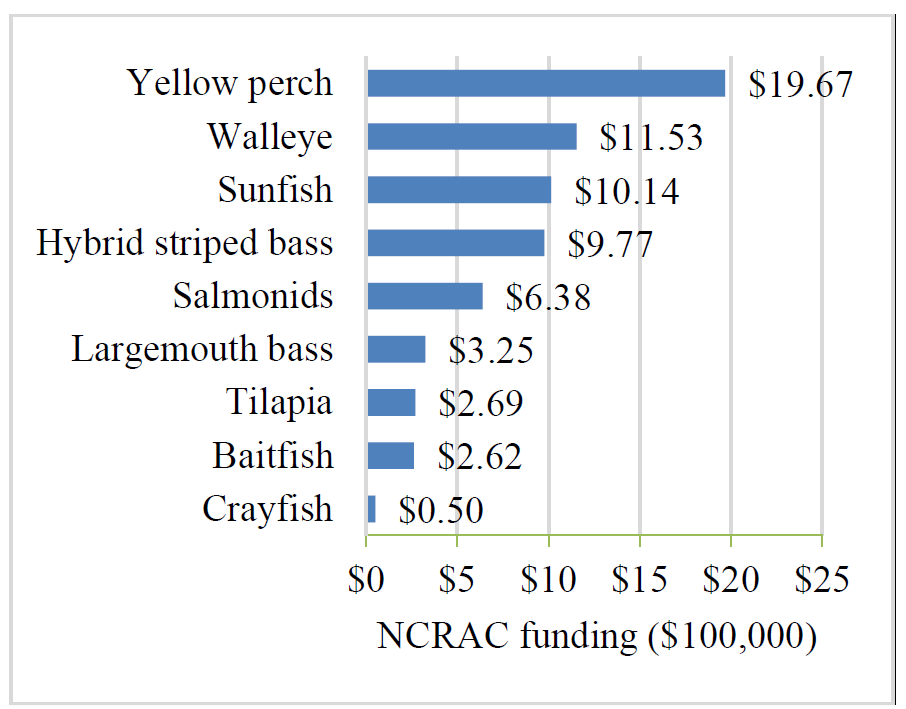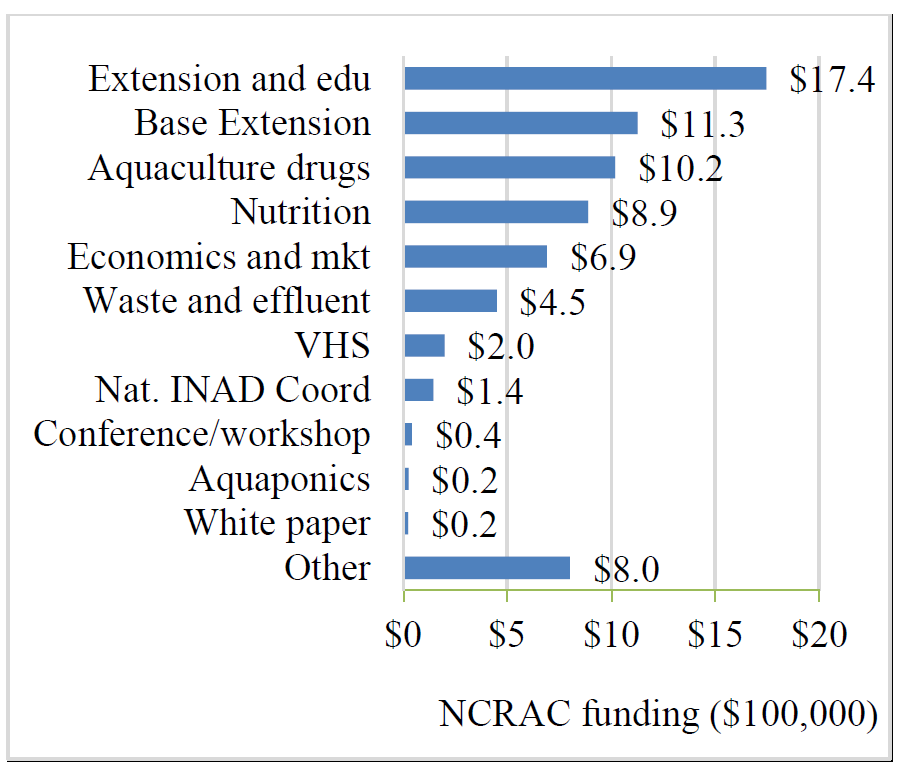Assessing the Effectiveness of NCRAC-funded Research in Aquaculture Within the North Central Region
ID
AAEC-318NP
Introduction
The North Central Regional Aquaculture Center (NCRAC) is one of the five Regional Aquaculture Centers mandated by the US government to advance and enhance viable and profitable commercial aquaculture production in the US for the benefit of producers, consumers, and the US economy. Since its inception in 1988, NCRAC has supported aquaculture projects that aim to advance and sustain the aquaculture industry in the North Central Region (NCR). However, little is known about whether NCRAC-sponsored projects have been achieving their intended purposes because there has not been a formal assessment of the effectiveness and impacts of NCRAC-funded projects. Knowledge of the effectiveness and impacts of NCRAC-funded projects is essential for the development of future projects that will improve and sustain the aquaculture industry in the NCR. This study reviewed NCRAC-funded projects and examined their effectiveness and impacts on aquaculture farms in the NCR.
Methods
A comprehensive review of NCRAC-funded project proposals and reports between 1988 and 2019 was conducted to summarize each funded project's objectives, procedures planned, anticipated benefits and impacts, outcomes accomplished, benefits and impacts reported, and recommended follow-up activities. Information obtained from the funded proposals and reports was used to develop a survey instrument to identify which projects were of benefit to aquaculture producers in the NCR. The survey was used to solicit from producers the type of research information needed, their preferred means of receiving information, the barriers to the success of their businesses, and their likelihood of participating in NCRAC activities. Questionnaires were sent via the online platform, Qualtrics, to 234 producers and a printed version was mailed to 280 additional producers. The survey was conducted anonymously with instructions to be completed only by commercial aquaculture producers in the NCR. The response rate was 15%, with 53 usable responses analyzed.
Results
NCRAC spent approximately $14 million on 125 aquaculture projects between 1988 and 2019 (Figures 1a and 1b). Fifty-nine (47%) of those projects attracted about $12 million in leveraged funding from other stakeholders. This means 46% of the total funding level ($26 million) was provided by other stakeholders. NCRAC-funded projects have resulted in several scholarly presentations and publications that communicate and transfer aquaculture-related information to stakeholders, including 187 Extension publications (fact sheets (56), bulletins (29), manuals/guides (34), videos/CDs (21), white papers (11), website articles (7), monitoring sheets (6), and other publications (23)) and 241 academic publications (journal articles (190), books/book chapters (10), and thesis/dissertations(41)) (Table 1). NCRAC-funded projects have supported the education of 41 graduate students.


Impact of adopting recommended information from Extension meetings and materials
Adoption of practices recommended in NCRAC- sponsored Extension meetings and materials has had a positive impact on aquaculture businesses in the NCR. This was evident through increased efficiency, production, fish growth, fish survival, fish quality, access to information, and profit reported by most respondents (Table 2).
Awareness and adoption of species-specific projects
Through NCRAC-funded projects, NCR aquaculture producers who raise fish species such as yellow perch, trout, walleye, tilapia, sunfish, and baitfish had gained awareness of several issues, especially issues related to culture technologies, dietary requirements, feeding strategies, optimum stocking density, and commercialization, had adopted the recommended practices, and those practices had impacted their farms positively.
|
No. of Extension pub. |
No. of academic pub. |
Total |
|---|---|---|---|
Species group |
|
|
|
Yellow perch |
7 |
45 |
52 |
Sunfish |
15 |
36 |
51 |
Walleye |
16 |
29 |
45 |
Hybrid striped bass |
1 |
27 |
28 |
Salmonids |
0 |
20 |
20 |
Tilapia |
2 |
15 |
17 |
Baitfish |
0 |
4 |
4 |
Crayfish |
3 |
1 |
4 |
Largemouth bass |
1 |
1 |
2 |
|
|
|
|
Other category |
|
|
|
Extension |
110 |
4 |
114 |
Aquaculture drugs |
5 |
16 |
21 |
Economics and marketing |
10 |
11 |
21 |
National INAD coordinator |
2 |
15 |
17 |
Nutrition |
1 |
11 |
12 |
White paper |
11 |
0 |
11 |
Waste and effluent |
1 |
4 |
5 |
VHS |
1 |
0 |
1 |
Conference/works hop |
1 |
0 |
1 |
Other |
0 |
2 |
2 |
Total |
187 |
241 |
428 |
Note: VHS is Viral Hemorrhagic Septicemia. Pub is publications.
Impact |
Direction |
Extension meetings (N=12) |
Extension materials (N=16) |
|---|---|---|---|
Efficiency |
Increased |
75% |
88% |
Production |
Increased |
67% |
69% |
Fish growth |
Increased |
75% |
69% |
Fish survival |
Increased |
67% |
81% |
Fish quality |
Increased |
50% |
50% |
Info. access |
Increased |
75% |
89% |
Profit |
Increased |
50% |
50% |
Note. Info. access is access to information.
Research needs of producers
Among 30 respondents who indicated the specific species they needed information on, 37% indicated yellow perch and walleye/hybrid walleye.
Largemouth bass, trout, sunfish, and shrimp were listed by 20% of respondents. Thirty-two respondents indicated research topics they needed information on. Seventy-two percent of them needed information on fish nutrition, followed by fish health (66%), culture technology (50%), water quality (41%), hatchery technology (41%), general aquaculture (38%), and marketing (25%).
NCRAC’s role in overcoming barriers to success of business
Regulations were the most common barriers with 44% of the 32 respondents selecting this, followed by lack of information on marketing and consumer education (16%), unavailability of fingerlings (13%), and lack of funds (6%). Among 24 respondents, 40% indicated that NCRAC had helped their businesses by providing them with general aquaculture research information and research information on specific problems. However, 52% of respondents indicated that NCRAC had not helped them to overcome their business challenges.
Producer recommendations for improvement of NCRAC
Major recommendations highlighted by respondents included the need for producer involvement in designing/executing research, need for increased collaboration between Industry Advisory Committee (IAC), Extension agents, researchers, and producers, and need for research that can be replicated on farms. Respondents also highlighted the need for more research on perch, baitfish, fish meal-free diets, and NCRAC assistance to address business challenges regarding the use of recirculating aquaculture systems.
Effective project approaches
NCRAC-funded project approaches that were effective and provided direct support to aquaculture businesses in the NCR were Extension projects; projects with strong engagement of Extension from conception to termination; projects that investigated enhanced culture methods; and projects that quickly responded to major farm level issues in the region, such as VHS.
Recommendations for NCRAC
Continued enhanced support for Extension projects and specialists to further increase Extension presence and direct farm level support.
There is a need for effective integration and engagement of Extension from initial planning and conception through pre- and full-proposal development and throughout all phases of project implementation.
There is a need to clarify the core mission, goals, and objectives of NCRAC internally. There are different perspectives within NCRAC as to whether its mission is to primarily develop new aquaculture businesses or to support existing aquaculture businesses with their problems, or some mix of the two.
NCRAC needs to strengthen and increase cooperation among Extension agents, researchers, and producers not only in listening sessions but in identification of specific regional aquaculture needs.
Create orienting and on-boarding package for people new to NCRAC, including a condensed version for those seeking membership of NCRAC, including IAC, Technical Committee (TC), and Board of Directors (BOD).
Researchers should be required to share progress through quarterly meetings with the industry and Extension liaisons on the project, and project results summarized through appropriate Extension deliverables.
Enhanced communication
There is a need for greater communication within NCRAC, within the NCR, with the aquaculture community outside the region, and with the public. P.I.’s should be expected to provide notification of the availability of project deliverables for posting on the website.
There is a need for a variety of approaches or formats of outputs that are used to deliver information to farmers. Workshops and conferences, followed by fact sheets, and email notices should form the backbone of an expanded communications program, and revitalization of NCRAC listservs.
There is a need for more communication with the general public to increase awareness of aquaculture related issues in the region.
To enhance collaboration within the region, an inventory of research and Extension capacity, including facilities and topical expertise should be developed and made available throughout the region.
NCRAC should list contact information of aquaculture Extension agents in the region, their specialties, and the areas they oversee on the NCRAC website.
NCRAC should continue to provide links to the other RACs on the NCRAC website.
Measures to reduce the regulatory burden on aquaculture businesses in the NCR are needed. NCRAC should form a committee (consisting of producers, researchers, and Extension agents) that will work closely with NCR aquaculturists to identify which regulatory issues to address and the best mechanisms that can be used to address regulatory issues in the region.
There is a need to develop an on-going impact- monitoring program that can lead to economic estimates of impacts. The end point of a NCRAC project needs to be more than publication of a journal article or fact sheet. A committee should be formed within NCRAC to develop a set of guidelines that require P.I.’s to include metrics for evaluation of the impact of the project, for pre-proposal and full proposals, and then report on the metrics in annual reports and termination reports.
NCRAC should continue to organize and host its regional aquaculture conferences and seminars. Consideration should be given to expanding these to reach more states in the region; producers requested such meetings in all 12 states. NCRAC could offer to send a representative on an ongoing basis to state aquaculture association meetings to give updates of NCRACs activities.
Conclusion
This study has contributed to the understanding of which projects have resulted in improved productivity and profitability of aquaculture in the NCR. Growth of yellow perch and walleye aquaculture production, in particular, was enhanced through NCRAC-funded projects. Aquaculture farms in the NCR had gained awareness and had benefited from adoption of information shared in NCRAC-funded studies. While no one research effort is ever entirely responsible for adoption of new technologies and their impacts, NCRAC has successfully leveraged other funding, such as Sea Grant, USDA-Animal and Plant Health Inspection Service, and veterinarian services on environmental quality, disease, and other issues. Though this study reveals the importance of NCRAC-funded research on aquaculture farms in the NCR, there are still some important issues that need to be addressed to improve NCRAC’s activities or increase NCRAC’s support for aquaculture farms, and consequently improve the aquaculture industry.
Reference
Agyeman, D.A, J. van Senten, C. Engle, R. Rode, K. Quagrainie, M. Smith, and D. Hill. 2023. Assessing the effectiveness of NCRAC-funded research in aquaculture within the north central region. Full report. Available at: https://www.ncrac.org/
Acknowledgments
This study was funded by USDA-NIFA, #2018- 38500-28887; NCRAC/Iowa State University, #019585J. Views expressed in this study do not reflect those of USDA-NIFA or NCRAC. The authors gratefully acknowledge the support of NCRAC officials who provided guidance for soliciting relevant information from NCR aquaculture producers. A special thanks to all NCR aquaculture producers who participated in this study. This study was successfully executed due to their voluntary participation.
Virginia Cooperative Extension materials are available for public use, reprint, or citation without further permission, provided the use includes credit to the author and to Virginia Cooperative Extension, Virginia Tech, and Virginia State University.
Virginia Cooperative Extension is a partnership of Virginia Tech, Virginia State University, the U.S. Department of Agriculture (USDA), and local governments, and is an equal opportunity employer. For the full non-discrimination statement, please visit ext.vt.edu/accessibility.
Publication Date
May 17, 2023



